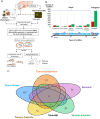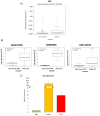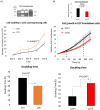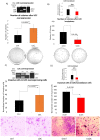Highly deregulated lncRNA LOC is associated with overall worse prognosis in Hepatocellular Carcinoma patients
- PMID: 33976720
- PMCID: PMC8100808
- DOI: 10.7150/jca.56340
Highly deregulated lncRNA LOC is associated with overall worse prognosis in Hepatocellular Carcinoma patients
Abstract
Although numerous long non-coding RNAs (lncRNAs) were reported to be deregulated in Hepatocellular Carcinoma (HCC), experimentally characterized, and/or associated with patient's clinical characteristics, there is, thus far, minimal concerted research strategy to identify deregulated lncRNAs that modulate prognosis of HCC patients. Here, we present a novel strategy where we identify lncRNAs, which are not only de-regulated in HCC patients, but are also associated with pertinent clinical characteristics, potentially contributing to the prognosis of HCC patients. LOC101926913 (LOC) was further characterized because it is the most highly differentially expressed amongst those that are associated with the most number of clinical features (tumor-stage, vascular and tumor invasion and poorer overall survival). Experimental gain- and loss-of-function manipulation of LOC in liver cell-lines highlight LOC as a potential onco-lncRNA promoting cell proliferation, anchorage independent growth and invasion. LOC expression in cells up-regulated genes involved in GTPase-activities and downregulated genes associated with cellular detoxification, oxygen- and drug-transport. Hence, LOC may represent a novel therapeutic target, modulating prognosis of HCC patients through up-regulating GTPase-activities and down-regulating detoxification, oxygen- and drug-transport. This strategy may thus be useful for the identification of clinically relevant lncRNAs as potential biomarkers/targets that modulate prognosis in other cancers as well.
Keywords: Hepatocarcinogenesis; Hepatocellular Carcinoma; LOC101926913; Long non-coding RNA; Prognosis.
© The author(s).
Conflict of interest statement
Competing Interests: The authors have declared that no competing interest exists.
Figures







Similar articles
-
Network of clinically-relevant lncRNAs-mRNAs associated with prognosis of hepatocellular carcinoma patients.Sci Rep. 2020 Jul 7;10(1):11124. doi: 10.1038/s41598-020-67742-8. Sci Rep. 2020. PMID: 32636408 Free PMC article.
-
New LncRNAs in Chronic Hepatitis C progression: from fibrosis to hepatocellular carcinoma.Sci Rep. 2020 Jun 18;10(1):9886. doi: 10.1038/s41598-020-66881-2. Sci Rep. 2020. PMID: 32555359 Free PMC article.
-
Long non-coding RNA CARLo-5 expression is associated with disease progression and predicts outcome in hepatocellular carcinoma patients.Clin Exp Med. 2017 Feb;17(1):33-43. doi: 10.1007/s10238-015-0395-9. Epub 2015 Oct 3. Clin Exp Med. 2017. PMID: 26433964
-
Long noncoding RNAs: Novel insights into hepatocelluar carcinoma.Cancer Lett. 2014 Mar 1;344(1):20-27. doi: 10.1016/j.canlet.2013.10.021. Epub 2013 Oct 30. Cancer Lett. 2014. PMID: 24183851 Review.
-
Roles and Regulation of Long Noncoding RNAs in Hepatocellular Carcinoma.Cancer Res. 2019 Oct 15;79(20):5131-5139. doi: 10.1158/0008-5472.CAN-19-0255. Epub 2019 Jul 23. Cancer Res. 2019. PMID: 31337653 Review.
Cited by
-
miRNA and lncRNA as potential tissue biomarkers in hepatocellular carcinoma.Noncoding RNA Res. 2023 Oct 24;9(1):24-32. doi: 10.1016/j.ncrna.2023.10.010. eCollection 2024 Mar. Noncoding RNA Res. 2023. PMID: 38075204 Free PMC article. Review.
-
The Role of Long Non-Coding RNA and microRNA Networks in Hepatocellular Carcinoma and Its Tumor Microenvironment.Int J Mol Sci. 2021 Sep 30;22(19):10630. doi: 10.3390/ijms221910630. Int J Mol Sci. 2021. PMID: 34638971 Free PMC article. Review.
-
Macrophage polarization in hepatocellular carcinoma: a lncRNA-centric perspective on tumor progression and metastasis.Clin Exp Med. 2025 May 25;25(1):173. doi: 10.1007/s10238-025-01711-1. Clin Exp Med. 2025. PMID: 40413657 Free PMC article. Review.
References
-
- Bray F, Ferlay J, Soerjomataram I, Siegel RL, Torre LA, Jemal A. Global cancer statistics 2018: GLOBOCAN estimates of incidence and mortality worldwide for 36 cancers in 185 countries. CA Cancer J Clin. 2018;68:394–424. - PubMed
-
- Farazi PA, DePinho RA. Hepatocellular carcinoma pathogenesis: from genes to environment. Nat Rev Cancer. 2006;6:674–87. - PubMed
-
- Sia D, Villanueva A, Friedman SL, Llovet JM. Liver Cancer Cell of Origin, Molecular Class, and Effects on Patient Prognosis. Gastroenterology. 2017;152:745–61. - PubMed
-
- Hartke J, Johnson M, Ghabril M. The diagnosis and treatment of hepatocellular carcinoma. Semin Diagn Pathol. 2017;34:153–9. - PubMed
LinkOut - more resources
Full Text Sources
Other Literature Sources

